DSP | Filters | Pole-Zero Placement
Calculators Theory Z-Domain Filters
Biquadratic PZ Placement Butterworth Chebyshev Prototypes IIR Filter
← Back to Digital Signal Processing
2nd Order Bandpass Filter Design
You are required to design a 2nd order bandpass filter using the pole-zero placement method. The normalised digital bandpass centre frequency is to be \(\Omega_{0} = 1.7279\) Rads, a bandwidth of \(0.01\) Rads and complete attenuation at \(0\) Rads and \(3.1416\) Rads.
Design the filter with the above specification and give your answer in the form described below.
So, for the poles, we have a radius of \(1-(bandwidth/2)\) which is \(1-0.005\). Therefore, the poles are;
\[(z-0.995e^{j \cdot 1.7279})(z-0.995e^{-j \cdot 1.7279})\] \[\therefore (z-0.995 \cdot cos(1.7279)+j \cdot 0.995 \cdot sin(1.7279))(z-0.995 \cdot cos(1.7279)-j \cdot sin(1.7279))\] \[= (z-(-0.1557 + j0.9827))(z-(-0.1557 - j0.9827))\]The zeros are at 0 and \(\pi\);
\[(z-e^{j \cdot 0})(z-e^{j \cdot 3.1416})\]This simplifies to;
\[(z-1)(z+1)\]Resulting in;
\[\frac{(z-1)(z+1)}{(z-(-0.1557 + j0.9827))(z-(-0.1557 - j0.9827))}\]To convert this to standard form, you can use poly in MATLAB, where;
f0 = 1.7279; bw = 0.01; att1 = 0; att2 = 3.1416;
z1 = cos(0) + 1i * sin(0)
z2 = cos(pi) + 1i * sin(pi)
p1 = (1-(bw/2)) * cos(f0) + 1i * (1-(bw/2)) * sin(f0)
p2 = (1-(bw/2)) * cos(f0) - 1i * (1-(bw/2)) * sin(f0)
poly([p1 p2])
ans =
1.0000 0.3114 0.9899
Thus, multiplying out the \(z\) in the numerator, we have the form;
\[\frac{K(z^{2}-1)}{z^{2} + 0.3114z + 0.9899}\]Adjust Form
Convert the above to the following form;
\[H(z) = K \times \frac{z^{2} + \beta_{1}z + \beta_{2}}{z^{2} + \alpha_{1}z + \alpha_{2}}\]Simply;
\[\displaylines{ \beta_{1} = 0.0000 \\ \beta_{2} = -1.0000 \\ \beta_{3} = 0.3114 \\ \beta_{4} = 0.9899 }\]Manual Calculation of Polys
To manually calculate the polynomials from the complex conjugate pair, we start with \(1\) and zero’d values for each complex number;
\[C = (1,0,0)\]Then;
\[C(2) = C(2) - e^{j \cdot 1.7279} \times C(1)\]for the first iteration and, remembering \(C(2)\) has now changed;
\[C(2) = C(2) - e^{j \cdot 1.7279} \times C(1)\] \[C(3) = C(3) - e^{-j \cdot 1.7279} \times C(2)\]Therefore, for the first iteration, we have;
\[C_{2} = 0 - (-0.1557 + j0.9827) \times 1 = 0.1557 - j0.9827\]Then, for the second iteration;
\[C_{2} = (0.1557 - j0.9827) - (-0.1557 + j0.9827) \times 1 = 0.3114 - j1.9654\] \[C_{3} = 0 - -0.1557 + j0.9827 \times 0.3114 - j1.9654 = 0.9899\]Thus, the result is the real values of \(C_{1,2,3}\).
Determine the Magnitude of the Gain
This functions similarly to the Biquad implementation;
\[\frac{K(z^{2}-1)}{z^{2} + 0.3114z + 0.9899}\]If \(\Omega = 0.7226\) Rads, then the Fourier response is;
\[|\frac{H(\Omega)}{K}| = \frac{e^{j2 \Omega} - 1}{e^{j2 \Omega} + 0.3114e^{j \Omega} + 0.9899} = \frac{cos(2\Omega) + jsin(2\Omega) - 1}{cos(2\Omega) + jsin(2\Omega) + 0.3114 cos(\Omega) + 0.3114 jsin(\Omega) + 0.9899}\]Combining the real terms together and the imaginary terms together;
\[|\frac{H(\Omega)}{K}| = \frac{(cos(2\Omega) - 1) + jsin(2\Omega)}{(cos(2\Omega) + 0.3114 cos(\Omega) + 0.9899) + j\{sin(2\Omega) + 0.3114 sin(\Omega)\}}\] \[\therefore |\frac{H(\Omega)}{K}| = \frac{1.32267427189203}{1.80401404861056} = 0.733184019775647\]Now, to determine the value of \(K\) so that the peak passband \(H_{peak} = 1.5\), we follow the same process, replacing \(Omega\) for \(f_{0}\) and multiplying the result by \(H_{peak}\);
\[K = \frac{(cos(2f_{0}) - 1) + jsin(2f_{0})}{(cos(2f_{0}) + 0.3114 cos(f_{0}) + 0.9899) + j\{sin(2f_{0}) + 0.3114 sin(f_{0})\}} \times 1.5\] \[K = \frac{1.80401404861056}{1.32267427189203} \times 1.5\] \[\therefore K = 0.0076\]MATLAB
f0 = 1.7279;
Omega = 0.7226;
Hpeak = 1.5;
p1 = 0.3114; p2 = 0.9899;
% calculate magnitude of H(Omega)
num = exp(j*2*Omega) - 1
denom = exp(j*2*Omega) + p1 * exp(j*Omega) + p2
magK = abs(num / denom)
% calculate K
Knum = exp(j*2*f0) + p1 * exp(j*f0) + p2
Kdenom = exp(j*2*f0) - 1
K = abs(Knum / Kdenom) * Hpeak
Time Domain
Determine the coefficients for the following equation that relates the time domain input and output for current time and the past times for the designed filter;
\[y[n] = c_{1}x[n] + c_{2}x[n-1] + c_{3}x[n-2] + c_{4}y[n-1] + c_{5}y[n-2]\]Looking at the transfer function, we first multiply out the brackets in the numerator;
\[\frac{K^{2}-K}{z^{2} + 0.3114z + 0.9899}\]Next, divide top and bottom by \(z^{2}\);
\[\frac{K-K^{-2}}{1 + 0.3114z^{-1} + 0.9899z^{-2}}\]Notice, the zeros only have values at powers \(0\) and \(-2\). Thus;
\[y[n] = 0.0076 \times x[n] + 0.0000 \times x[n-1] + -0.0076 \times x[n-2] + -0.3114 \times y[n-1] + -0.9899 \times y[n-2]\]The filter is to be implemented with the following structure;

What are the values?
\[a = -0.3114, b = -0.9899, c = 0.0076, d = 0, e = -0.0076\]